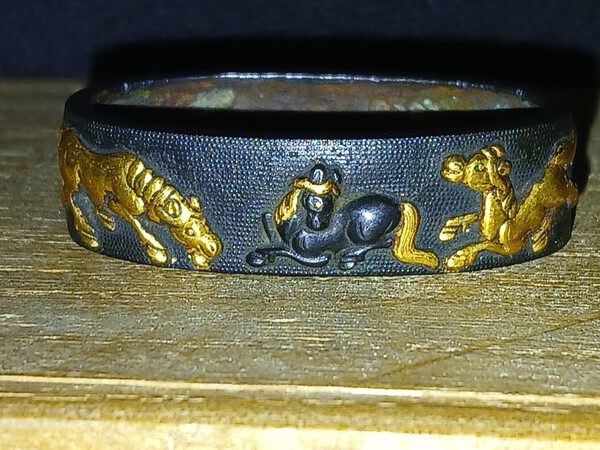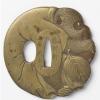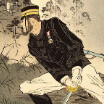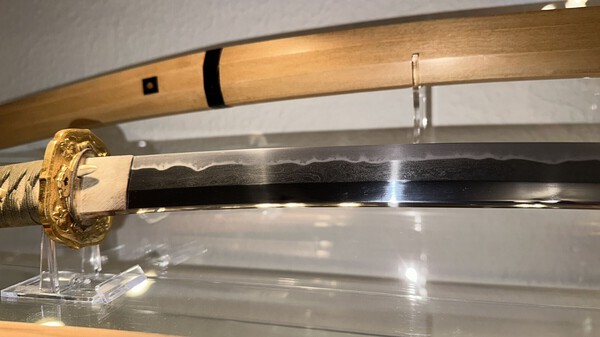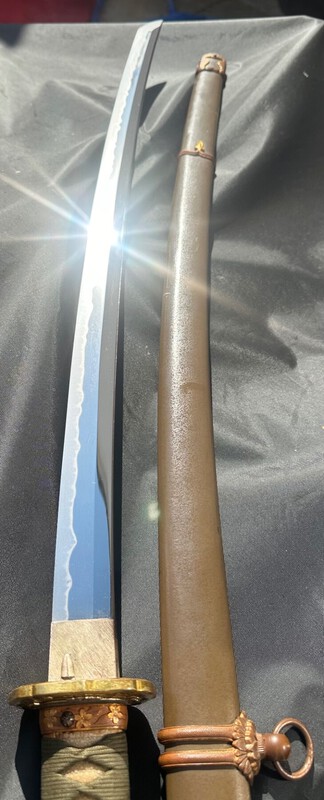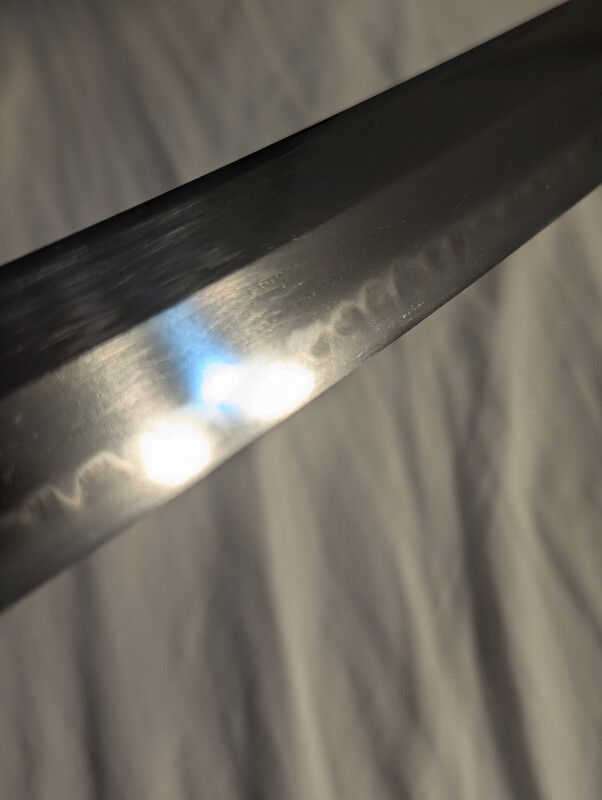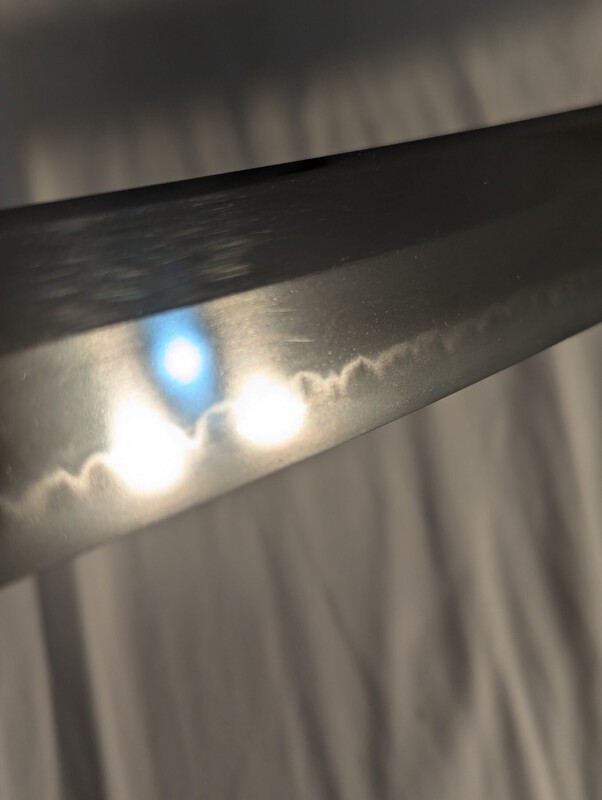Leaderboard
Popular Content
Showing content with the highest reputation on 09/04/2024 in all areas
-
11 points
-
6 points
-
5 points
-
Note, this is a couple of years old. She also did a day with a smith (Masataka Futsuno); link is at the end of this video. And her shtick seems to be kinda anime clothes (which perhaps isn't so surprising for a youtuber in Japan). Some of it is in English; most in subtitles. Interesting, though very much focused on the general public. Polisher seems like a very nice guy.5 points
-
3 points
-
I have decided to do the patina again after I made the video because there are some ugly spots… But it looks cool in the video so here it is and I don’t think it will change much.3 points
-
3 points
-
@Josharic & @Bruce Pennington as noted your swordsmith is from Gifu, Yoshinori” (嘉則), real name Matsuyama Umeharu (松山梅春). He was born Meiji 43 (1910) August 26 and from Nagasumi-cho in Seki-machi. He registered as a Seki swordsmith on Showa 17 (1942) April 9 (age 31). In the 6th Shinsaku Nihontō Denrankai exhibition in 1941 he was ranked as Fifth Seat (5/5). In 1942 there was a list (Banzuke) of around 400 swordsmiths; with around another 44 smiths he was an additional late entry, in the category of Shinshin (新進) ("new comer") (5/5). Some oshigata: 1. Seki Matsuyama Yoshinori saku (Japanese Gendai Swordsmiths). 2. 勇 現代刀業物 関住松山嘉則 軍刀展刀匠第1部新作刀第五席新進 二尺一寸四分五厘 切れ味のいい傑作刀 蔵出し 刀 日本刀(刀、太刀)|売買されたオークション情報、yahooの商品情報をアーカイブ公開 - オークファン(aucfan.com) (nagasa 65.0 cm, sori 1.1 cm)3 points
-
3 points
-
Jacques, I respect Zenon's opinion, but why did you not follow his advice? You are not really helpful when you put up the yardstick in unreachable height! Of course you are correct that looking at and handling good blades is the real thing, but what novice can start at this level? And to get a bit more personal: You have a very high level of competence, but how was your own start into this field? Maybe you inherited a collection or had a friendly mentor to guide you? Looking at myself, I did not have opportunities to see or learn from good blades when I started almost 50 years ago. There were just a few books in English available, and they were expensive (and not all were good as I know today). Looking at high-end blades was impossible, and still today, many wealthy collectors keep their treasures well protected and away from curious newbies. Today, I could join the local NBTHK assembly or the only sword-club available but I would have to drive quite far for it - once or twice a year! I think it is not so easy for beginners, and we should encourage them, hoping they will be patient enough for a long learning journey.2 points
-
Pretty. Both the Uesugi family and the Date clan of Sendai and Uwajima, used bamboo and sparrow arrangements for their kamon, Jean.2 points
-
2 points
-
2 points
-
2 points
-
True. And also studying paintings is pointless, since the 3D texture of the paintwork is just as important as the design, and the way it is viewed in natural light is the only way to truly appreciate art. And studying ceramics is pointless unless you see them in real life and are able to view and feel the actual surface and textures. And looking at pictures of cars is pointless, you really need to drive them to understand the attraction. Hmm....collecting and studying custom knives is also a waste of time from pics. You need to feel it in hand and appreciate the sharpness and fit and finish. Actually...now that you mention it, collecting and studying anything is really pointless unless we have it in hand. I see now we are all wasting our time. I suggest everyone stop collecting and studying absolutely everything unless you have the chance to see every example in hand. Everyone, stop immediately. Thanks for showing us the light.2 points
-
I forgot all about this tsuba I bought as part of a job lot from the Albert Newall (artist and antique dealer) collection a few years ago. I think that I have posted it before, but.. At first glance the tsuba appears to be from a European rapier, but the nakago ana shows its Japanese origin. The Japanese had a craze for Portuguese and Spanish armour in the late 16th C (Momoyama) and perhaps this tsuba dates from then. The iron on the inside has become delaminated, which again makes me believe that this tsuba was made from Japanese folded iron. The inside is coated with red lacquer and I think it would be interesting to have this carbon-14 dated. The tsuba is a thin steel wan-gata (tea bowl) shape and has a large inome (boar’s eye) cut into the top. Usually, Japanese tsuba have four inome and the large single one on this tsuba makes me believe it is a European heart shape; the Heart of Jesus being a powerful symbol of the catholic faith. The tsuba is also decorated with gold and silver highlighted engravings, including three phoenixes in gold (sorry about the photo which does not make them clear). The phoenix is a bird that rises from the ashes, i.e. is resurrected, and the Christian panoply of gods is made up of the trio Father, Son and Holy Ghost. So, is this a Christian tsuba? Best regards, John2 points
-
2 points
-
2 points
-
@Markus Don't forget to post these specials here on the forum too. We can't always rely on people stumbling across them and posting it here. As you can see, it bears fruit2 points
-
The appearance of the nakago patina is very unusual, which you can see both where patina runs into the nakago mune and at the habaki-moto (compare with a normal and natural sabigiwa). My impression is that the piece has been repatinated. I'm not trying to put down something that you said was intended to be an inexpensive display piece, just sharing my thoughts as you posted here for feedback.2 points
-
2 points
-
Its not often an opportunity presents itself to handle a blade by arguably the most famous Japanese swordsmith, Masamune. The owner was Albrecht Von Roretz and he brought this blade along with 60 others from Japan in the late 1800's, after several years spent establishing a modern Western health system during the Meiji period. He had a keen interest in Nihonto which makes this particular Masamune worthy of a hands on viewing. Markus Sesko was supposed to inspect the collection but left for the USA before getting the chance. There are certainly some questions as to whether this is a genuine blade by the Master but given Dr Von Roretz's status, knowledge around the subject etc, its worth giving it a careful look. I will ask if I can take some photos and if possible, view the Nakago.1 point
-
1 point
-
Forum noun 1. A place, meeting, or medium where ideas and views on a particular issue can be exchanged. If not for this forum+books, I would have surely ruined a blade or two in my time collecting. Thank goodness forums like this exist, otherwise how many Nihonto would have ended up on the belt sander because people didn’t know better? For what it's worth, I inherited a sword at 11 years old. I didn't even know the word "NIHONTO" until I was 21. Thanks to books and this forum, I know much more now; and I am more prepared to appreciate blades in hand, when I am fortunate enough to view them. @Jacques D. your overly idealistic views on sword study totally neglect those of us who simply don't have easy access to swords, experts, polishers, and maybe most importantly: wealth. We simply can't all have those privileges. With all due respect, -Sam1 point
-
1 point
-
1 point
-
It is interesting in these period photos to see the majority of swords had leather covers.1 point
-
Your Seki stamp shows that sword is not traditionally made. He is probably in the low-medium grade Showato range.1 point
-
I like them both. If I had the money I’d buy the Kajiyama Yasunori (Yasutoku). Looks like a high quality sword from a top notch Yasukuni Tosho with a very early date. Comes in fantastic polish in new shirasaya also with original gunto koshirae and origami to boot.1 point
-
There is a similar Wangata in the Ashmolean museum shallower cup and two piercings later filled with silver. Two suhama ("sand-banks", three-lobed devices forming the badge of the Sanada) EAX.10158 http://jameelcentre....ection/7/10237/10344 I like the vermillion red lacquer on the ura. [PS good luck finding the ura image on-line. Why do museums like to hide things?]1 point
-
I found two other swords by this swordsmith. @Markus Below is the first one. Not much other than the characters. Interpreting kanji on samurai sword The second one is in naval fittings, same as the one in the OP. It is over at auctree, item b1106655914. I will post the link but it will come up forbidden. It has the same style habaki as the OP. https://aucfree.com/m/items/b11066559141 point
-
Hi John! You've got a very fine Mantetsu sword there! 2nd photo Koa Isshin Mantetsu made this 3rd 1942 Spring Serial number: RA 1027 Interesting note, you now have the earliest know Mantetsu blade with the "W/M" stamp! Our understanding is that it is a "halfway inspection" mark. It's seen on all sorts of military equipment of the era, but they started showing up on blades in 1942 when the Army assumed control of all sword production. Ray's link has all the essentials. For a more in-depth read, you can download our South Manchurian Railway - The Mantetsu Blade article. @Kiipu @BANGBANGSAN1 point
-
Please see below regarding mantetsu-to. https://www.japaneseswordindex.com/koa.htm1 point
-
What if you could sit down with a polisher, or a nihonto expert, or even a swordsmith to study swords together? How about all three? In essence that is what books to some extent allow you to do. One of the very first steps in sword study is learning and developing one's vocabulary. Otherwise, how do you know where to begin to learn, and what it is that you're studying? Conversely, what do these new words really mean without access to a sword with these features? We often see right here on the NMB the results of what happens in the rush to obtain a Japanese sword before reading books and developing a proper library, never mind an extensive library. And sometimes poor results still occur even after books are purchased and read because the buyer has never really held and studied excellent nihonto in excellent polish in hand. Ignorance of one's own ignorance may be the worse kind of ignorance. Especially when it comes to Japanese swords. For those that really want to challenge themselves as well their reference material they should write up a kantei for the sword or swords being studied, including a discussion of how to reach the correct conclusion along with citing all references. It was doing exactly this for our local study group that raised the bar for learning how to critically study and learn from books with sword in hand.1 point
-
First blade I have seen from him: YOSHINORI (嘉則), Shōwa (昭和, 1926-1989), Gifu – “Yoshinori” (嘉則), real name Matsuyama Umeharu (松山梅春), ryōkō no jōi (Akihide), Fifth Seat at the 6th Shinsaku Nihontō Denrankai (新作日本刀展覧会, 1941)1 point
-
1 point
-
1 point
-
1 point
-
Dear Cornelius. I think Yoon has suggested that the signature may bee Nobumitsu rather than Nobuiye. All the best.1 point
-
1 point
-
In my humbled opinion, the best material on the subject in English is the 59 volume set of English Token Bijutsu written by the staff of the NBTHK: https://japaneseswor...ition-all-59-issues/ on my site. While there you can search for many of the other books mentioned here to get an idea what they're like. Cheers, Grey1 point
-
Scott: Not to disparage your purchase, however that particular seller often, but not always, sells blades with some sort of problem. Not that they aren't real, just that there will be some sort of defect, blemish, or other issue. Just keep that in mind for future purchases. I personally have no problem with buying from him, just know what you are getting and look for the issue. His pictures are generally good enough to look the blade over carefully. Just my two cents. John C.1 point
-
Just to clarify my previous comment - the wear is just so even! There just doesn't seem to be any marks from people taking it out of koshirae like there are on my blades. Here's some pics for comparison - I think you'll see what I mean (note the shinier steel on the edges): I wonder if this could all be explained by it having been in an old shirasaya for a very long time, building up the even patina without any wear, and then it had a newer polish that removed most of the transition between the patina and polished steel?1 point
-
... I guess condition is unusual. I was involved once in a rough evaluation of Reich chancelorie and department of foreign affairs properties taken by the Soviet Union. Nothing appeared terribly interesting, mostly modern-Meiji things, actually there was considerably more Chinese pottery and decorative paintings (in 1920s there was a lot of back and forth gift exchanges) with the emphasis on pretty. There are plenty of personal/diplomatic Asian gifts everywhere, they are just not spectacular and more often than not budget friendly.1 point
-
A three part interview of Paul Martin conducted by Shohei Nagatsuji of Japan-Forward.com. Interview1 point
-
It's nice to be able to see the efforts of various Togishi, along with their names.1 point
-
1 point
-
Ah, yes, I remember that one. Very nice. And this other one has plenty going for it too. Notice the bukunaoshi plug showing the pan has been rebuilt, a sign of much use in its time! Both typically flashy Sakai guns, but definitely better quality examples, worth preserving. Glad they have found a loving home. Perhaps you lived in Sakai in a previous life. There is an interesting novel on Sakai smiths which I translated for the book that Jan and I are writing together. Taking this as a challenge, I started working on the unusual Mei. It comes out as 摂州成合住金屋七郎 作 半巻張 "Living in Nariai in Sesshu, Kaneya Shichiro Saku. Han makibari" (Half bound). There is a company that reads 成合 as Seigo, but Nariai may be the correct local area reading. There is a record of an archaeological tomb excavation there. Han makibari must have been a proud statement back in the Edo Period when makibari binding was a rare and desirable feature, but then smiths started doing 'full makibari', then 'double', and later 'triple'.1 point
This leaderboard is set to Johannesburg/GMT+02:00






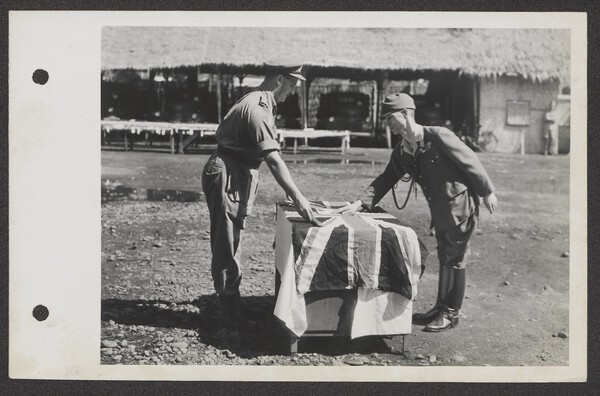




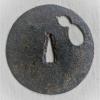



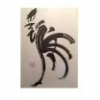



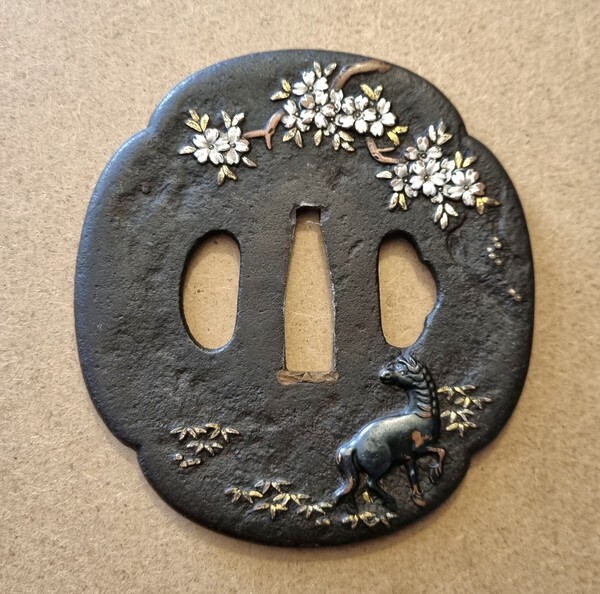
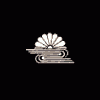
















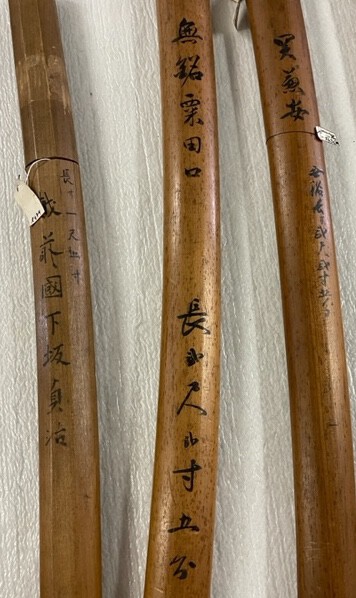

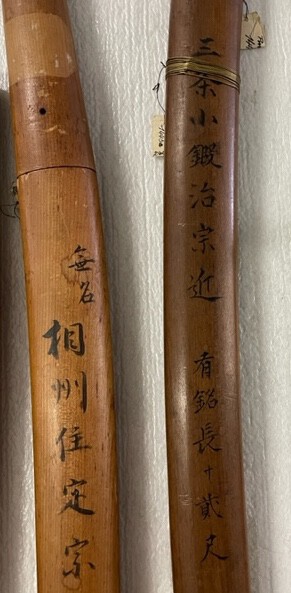






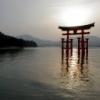
.thumb.png.4c5df79fec171b2dc4a23af38e280a4d.png)
